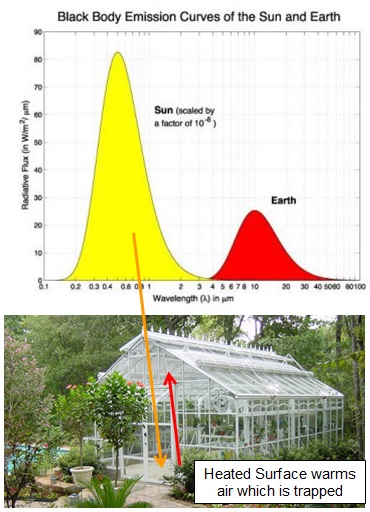Climate Illuminated

Greenhouse GHE and GHG

“The core idea of greenhouse theory is that downward radiation from greenhouse gases raises the earth's surface temperature higher than solar heating can.” Link to AmericanThinker Article
The real Greenhouse Effect (GHE) occurs in an enclosed structure typically used for growing plants. A greenhouse is an enclosed mechanical structure, which has either glass or plastic walls and overhead roof. Incident sunlight consisting of Ultra-Violet, Visible, or Near-Infrared (IR) (short-wavelength) light is transmitted through the glass or plastic. It warms surfaces within the structure, which then primarily by conduction and then convection, warms the air within the greenhouse. The warmed surfaces also in turn, radiate long-wavelength IR upward, although this is a minor contribution to heating that occurs within the greenhouse. The critical and most important thing to remember is that the greenhouse is a closed environment. The consequence of its being closed, is that the warmed air (warmed by whatever mechanism) is trapped within the closed environment. Warmed air rises, resulting in an increasing temperature gradient upwards, with the highest temperature being at the highest point of the greenhouse. It is critically important to understand this concept!
To further reinforce this concept, consider an experiment that can be easily performed within one’s own home. In a small room, such as a bedroom, with a closed door and windows, and no forced air vents active to minimize air currents, make temperature measurements a few inches below the ceiling and a few inches above the floor. Make the measurements after sundown, to eliminate sunlight coming in through the windows. The temperature near the ceiling will be warmer than near the floor. (Our test resulted in the temperature near the ceiling being about 5oF warmer than near the floor.) This is also a closed environment, which has an increasing temperature with height, a direct result of both the closed environment, and gravity. Warmer air is less dense and floats upward, with colder, denser air being confined to the lower space.
Illustrated below is solar radiation, shown in yellow, and the long-wavelength IR radiation emitted from the Earth in red (different vertical scales for solar radiation and Earth’s emitted long-wavelength IR). The vertical scale shows the radiation flux in Watts/m2, with wavelength in microns on the horizontal axis.

Heated Surface warms air which is trapped
The AGW alarmists have co-opted this concept for its emotional value in conjuring up images associated with the other common term for a greenhouse, namely “hot house” with the obvious implications for elevated temperatures. The AGW alarmists never concisely and specifically explain how the GHE functions in the atmosphere, which is completely and fundamentally a different situation from an actual greenhouse.
In contrast to the actual greenhouse, closed environment case, the atmosphere is an open environment. Because of the open environment, the temperature gradient in the atmosphere is reversed from that in a greenhouse. The drop in temperature with altitude, called the Lapse Rate, is characterized by completely different physics. Applying the term GHE to the atmosphere is erroneous, although the term is commonly used by both AGW alarmists and skeptics alike.
In the atmosphere, gases in the atmosphere are heated during the day mostly by the warmed surface of the Earth. The warmed gases become less dense and therefore rise in the presence of Earth’s gravitational field. However, unlike the closed environment of the greenhouse, the warmed gases are not trapped, and will continue to rise, cooling in the process as they become less dense, according to the Ideal Gas Law. This results in a decreasing temperature with increasing altitude. For many people this should be commonly experienced: in California, think of the colder temperature in the Lake Tahoe region, compared to the Central Valley, or the colder temperature on top of Mt. Whitney, compared to Death Valley.
Similarly, using the term Greenhouse Gas (GHG), or gases is also completely erroneous, but also seems to be common practice, again too commonly, for both AGW alarmists and skeptics. A preferred and more accurate term would be IR-Active Gases, which will be used throughout this discussion. IR-Active Gases denote gases which actively absorb and emit IR radiation. By far, the most dominant of these gases is Water Vapor, which is about 1000 times more effective at absorbing and emitting long-wavelength IR radiation than is CO2. Other lesser IR-Active Gases are Methane, Nitrous Oxide and Ozone. The other, much more prevalent gases in the atmosphere, Nitrogen, Oxygen, and Argon, are not active gases with respect to IR radiation.
Invoking the GHE and GHG concepts for the atmosphere in order to explain “global warming” violates fundamental laws of physics. This will be discussed further, and examples will be given that are common to everyone’s experiences.
We should revisit occasionally what the proper role of government is. As the constitution was a good sense of direction, we need a core set of principles to add in order to deal with the future.
So many want to engineer society, remove risk, assist certain groups, rather than let individuals thrive and raise communities. Why?
Is Democracy where we all "get it good and hard" or is it the best means to a free society?
Should we roll with the special interests, or make the government achieve its proper role, what is that role, and how to do this?
When do deficits and governments become too large?
Government is becoming more elitist while trying to sell corrections to problems it created, what makes this possible?